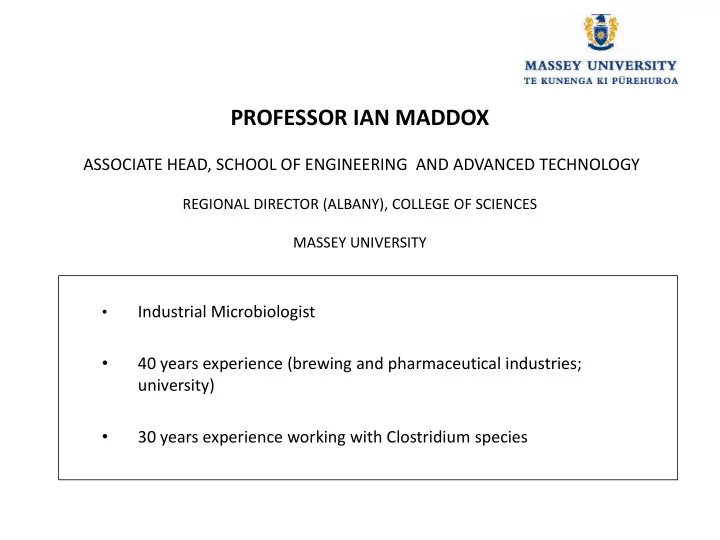

PROFESSOR IAN MADDOX ASSOCIATE HEAD, SCHOOL OF ENGINEERING AND ADVANCED TECHNOLOGY REGIONAL DIRECTOR (ALBANY), COLLEGE OF SCIENCES MASSEY UNIVERSITY • Industrial Microbiologist • 40 years experience (brewing and pharmaceutical industries; university) • 30 years experience working with Clostridium species
• 30 years experience with the acetone-butanol-ethanol (ABE) fermentation process, which uses Clostridia to convert sugars to ABE. • Published over 50 refereed articles and reviews on ABE process. Acknowledged worldwide expert.
Our environment is rich in microbial diversity • Bacteria are very small one-celled organisms about 0.2-2µm wide and 1-10µm long* • A teaspoon of soil productive soil generally contains 100 million to 1 billion individual bacteria* • An acre of land may contain a ton of bacteria representing of a million different species* *The Role of Soil Bacteria , JJ Hoorman (Ohio State University fact sheet SAG-13-11)
). The vast diversity of microbes in NZ is unknown Group Marine Land-based Freshwater Bacteria 2 40 309 341 Protozoa (single-celled eukaryotes – organisms whose cells have membrane-bound 1,663 671 465 nuclei) Chromista (group of eukaryotes other than protozoa) 855 158 922 Plants 626 5,165 1,107 Fungi 3 3 6,781 255 Animals 12,637 20,337 2,410 Total 4 15,824 33,421 5,500 New Zealand's native species There are an estimated 80,000 native species in New Zealand. Almost 55,000 of these have been identified and about 30,000 have been scientifically described, named and classified. Number of known 1 native species in New Zealand, 2007 Notes: (1) This includes the numbers of described species plus known species that have not yet been described. (2) The numbers given for bacteria are based mainly on cultured species in New Zealand. Some of these have not been broken down according to their environment - most are land-based. (3) The numbers given for aquatic species of fungi are approximate. (4) The totals provided do not equal the sum of the rows as there is some overlap due to different life-history stages in different environments (for example, aquatic larval stages and land- based adult stages From the environment report Environment New Zealand 2007 ( ISBN: 978-0-478-30191-5)
The acetone-butanol-ethanol (ABE) fermentation process • uses Clostridium acetobutylicum or Clostridium beijerinckii. Sporeformers. Anaerobic. • Commercialised in WW 1 as source of industrial chemicals from sugars. • Between 1920 and 1985, commercial plants operating in UK, USA, Japan, China, Europe, Russia, South Africa.
• Typical scale 20,000 - 50,000 litres in banks of 10-20. • Hygienic design and operation. • Petrochemical sources of ABE dominated from 1960 onwards. • From 2000, biofuels make a “comeback”. • Commercial ABE plants currently operating in China, Brazil. • ABE - producing bacteria are easily isolated from anaerobic environments worldwide. Non-pathogenic. • Many ABE - producing bacteria have been imported into NZ, with MAF permits, over the last 30 years, with no evidence of any adverse impact on soil, biodiversity, aquifers, or any anaerobic environment. No evidence of any adverse impact on environment or biodiversity in NZ or Globally.
Analogy between ABE process and and Lanzatech’s process • Similar anaerobic fermentation technology, hence expertise available. Use of anaerobic clostridia. But LanzaTech strain does not sporulate. • LanzaTech process uses gas; ABE process produces waste gas (C0 2 + H 2 ) • ABE uses sugars. LanzaTech uses C0 2 , hence uses a greenhouse gas rather than potential food.
• Production of fuel and useful chemicals from greenhouse gases is environmentally sensible. • Biorefineries, based on C0 2, will become a reality due to high cost of oil and environmental concerns.
Recommend
More recommend